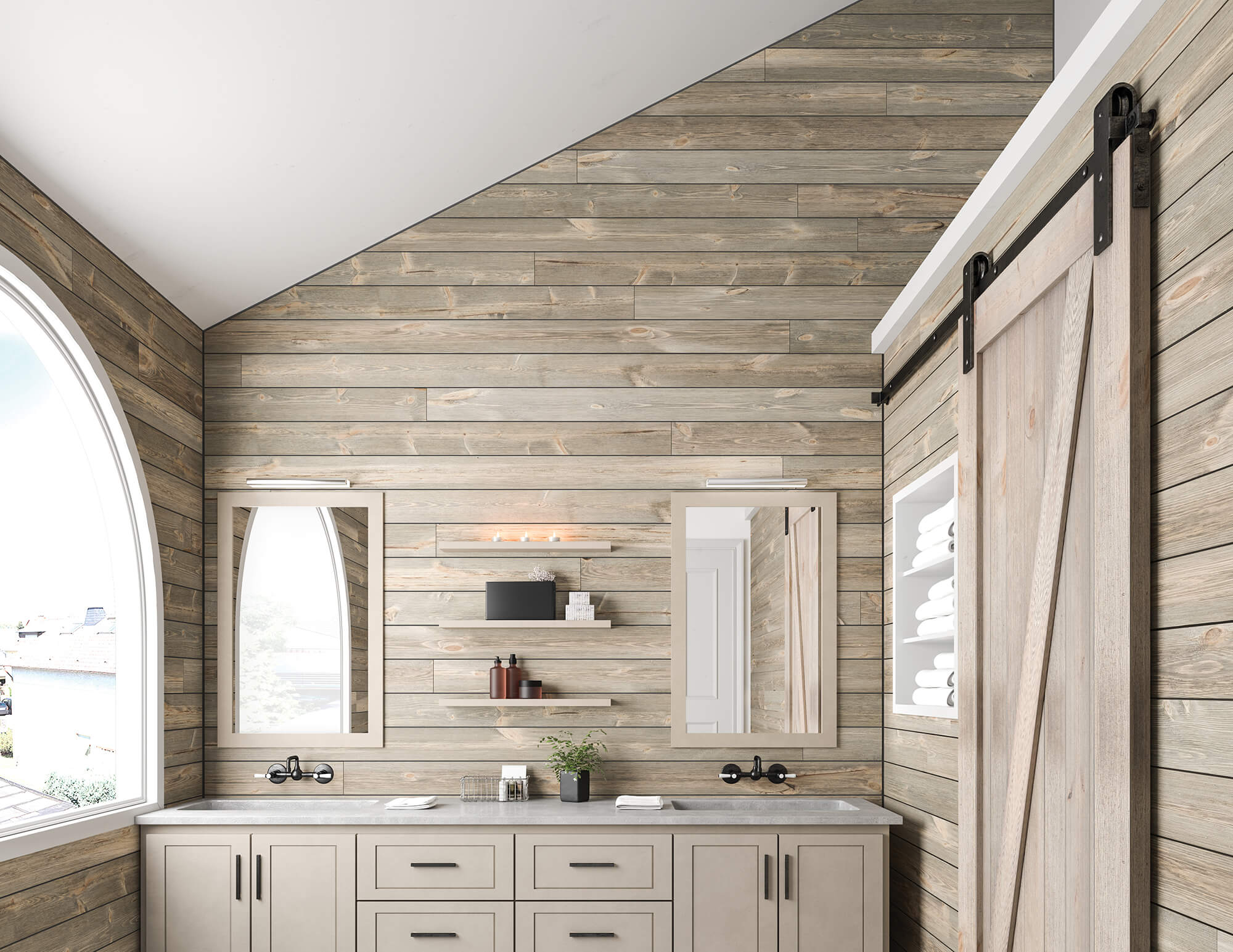Shiplap Wall and Ceiling Design Options
Shiplap bathroom walls and ceiling – Shiplap is a versatile and stylish wall and ceiling treatment that can add character and charm to any space. It is available in a variety of widths and can be installed in a variety of patterns to create different looks.
One of the most popular shiplap patterns is the horizontal pattern. This pattern is created by installing the shiplap boards horizontally, with the edges of the boards overlapping. This pattern is a classic choice that is perfect for both traditional and modern homes.
Another popular shiplap pattern is the vertical pattern. This pattern is created by installing the shiplap boards vertically, with the edges of the boards overlapping. This pattern is a more modern choice that can add a touch of drama to any space.
Shiplap can also be installed in a diagonal pattern. This pattern is created by installing the shiplap boards diagonally, with the edges of the boards overlapping. This pattern is a unique choice that can add a touch of interest to any space.
In addition to the different installation patterns, shiplap can also be combined with other wall treatments to create a variety of looks. For example, shiplap can be painted or stained to match the existing décor. It can also be combined with wallpaper or other wall coverings to create a unique and personal style.
The shiplap bathroom walls and ceiling create a rustic and cozy atmosphere. To enhance the aesthetics, consider adding a touch of color with pink bathroom wall art. These decorative pieces can complement the shiplap walls and bring a feminine and vibrant touch to the space.
The combination of shiplap and pink wall art creates a charming and inviting bathroom environment.
Shiplap Widths
Shiplap is available in a variety of widths, from narrow to wide. The width of the shiplap boards will impact the overall aesthetic of the space. Narrow shiplap boards will create a more delicate look, while wide shiplap boards will create a more rustic look.
Shiplap bathroom walls and ceilings create a rustic, charming aesthetic. If you’re looking for a more modern, sleek look, consider Kohler bathroom wall panels. These panels are available in a variety of colors and finishes, and they’re easy to install.
They’re also moisture-resistant, making them ideal for bathrooms. You can use them to create a seamless, waterproof look that will last for years to come. Of course, shiplap bathroom walls and ceilings will always have their own unique charm, but if you’re looking for a more modern, low-maintenance option, Kohler bathroom wall panels are a great choice.
Combining Shiplap with Other Wall Treatments
Shiplap can be combined with other wall treatments to create a variety of looks. For example, shiplap can be painted or stained to match the existing décor. It can also be combined with wallpaper or other wall coverings to create a unique and personal style.
Material Considerations for Shiplap Bathrooms
When selecting materials for shiplap in bathrooms, it is crucial to consider factors such as moisture resistance and durability. Different materials offer varying advantages and disadvantages, so careful consideration is necessary to ensure longevity and aesthetic appeal in the humid environment of a bathroom.
Wood, Shiplap bathroom walls and ceiling
- Advantages: Natural beauty, warmth, and versatility in terms of finishes and textures.
- Disadvantages: Requires regular maintenance to prevent moisture damage, warping, and rot.
PVC
- Advantages: Highly moisture-resistant, durable, and low-maintenance.
- Disadvantages: Can appear less natural than wood, and may not be as durable in high-traffic areas.
MDF
- Advantages: Affordable, moisture-resistant, and easy to install.
- Disadvantages: Can be less durable than wood or PVC, and may not be suitable for high-moisture areas.
Choosing the Right Finish
In humid environments, it is essential to choose a finish that protects the shiplap from moisture damage. Consider finishes such as:
- Polyurethane
- Oil-based paint
- Moisture-resistant primer
Installation Techniques for Shiplap Bathrooms: Shiplap Bathroom Walls And Ceiling

Installing shiplap in bathrooms requires precision and attention to detail. Follow these steps for a successful installation:
1. Prepare the Walls and Ceiling
Ensure the walls and ceiling are level, plumb, and free of imperfections. Install a moisture barrier, such as a vapor barrier or cement board, to protect against moisture.
2. Mark the Studs
Locate the studs using a stud finder and mark their positions on the walls and ceiling. This will guide the placement of the shiplap.
3. Install the Bottom Course
Start by installing the bottom course of shiplap. Cut the boards to the desired length and nail them into the studs, leaving a small gap between each board for expansion.
4. Continue Installing Shiplap
Work your way up, installing the remaining courses of shiplap. Stagger the joints to create a stronger and more aesthetically pleasing finish.
5. Cut and Fit Around Obstacles
For areas around windows, doors, and other obstacles, measure and cut the shiplap to fit precisely. Use a miter saw for angled cuts.
6. Nail and Finish
Nail the shiplap into the studs using galvanized nails. Countersink the nails slightly and fill the holes with wood filler. Sand the surface smooth and apply a sealant or paint for protection.
Common Installation Challenges and Solutions
1. Warping and Buckling
– Ensure the shiplap is acclimated to the bathroom environment before installation.
– Install a moisture barrier to prevent moisture from warping the shiplap.
– Use a level to ensure the shiplap is installed straight and plumb.
2. Gaps Between Boards
– Cut the shiplap precisely and leave a small gap for expansion.
– Use a nail gun to ensure the boards are securely fastened.
– Apply caulk or wood filler to seal any gaps.
3. Nail Pops
– Countersink the nails slightly to prevent them from popping out.
– Use galvanized nails that are resistant to rust.
– Apply wood filler to the nail holes and sand smooth.